engine FIAT DOBLO COMBI 2018 Owner handbook (in English)
[x] Cancel search | Manufacturer: FIAT, Model Year: 2018, Model line: DOBLO COMBI, Model: FIAT DOBLO COMBI 2018Pages: 272, PDF Size: 23.75 MB
Page 80 of 272
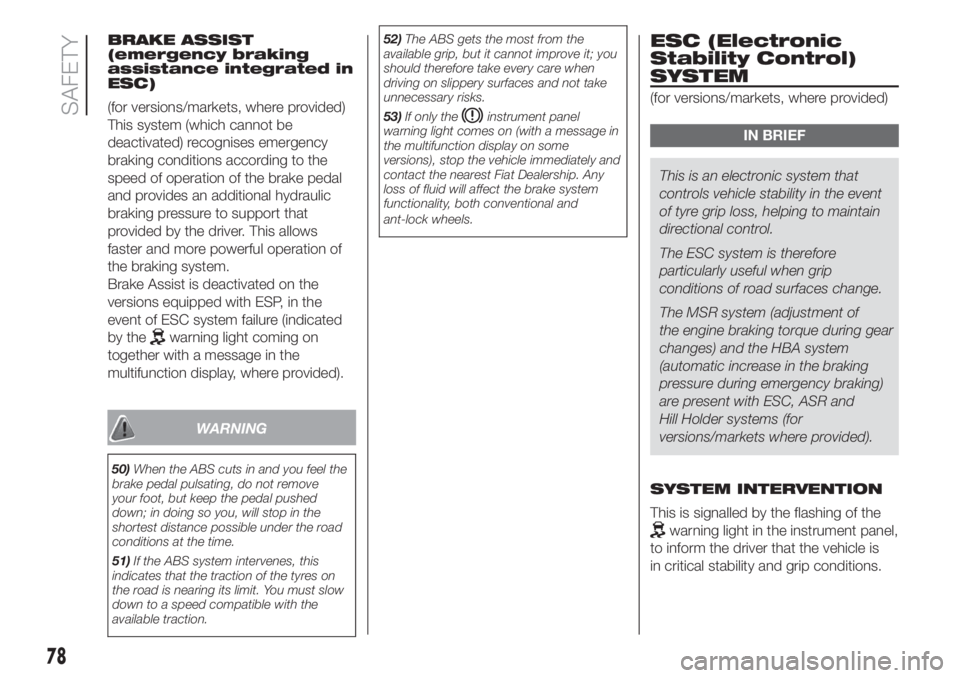
BRAKE ASSIST
(emergency braking
assistance integrated in
ESC)
(for versions/markets, where provided)
This system (which cannot be
deactivated) recognises emergency
braking conditions according to the
speed of operation of the brake pedal
and provides an additional hydraulic
braking pressure to support that
provided by the driver. This allows
faster and more powerful operation of
the braking system.
Brake Assist is deactivated on the
versions equipped with ESP, in the
event of ESC system failure (indicated
by the
warning light coming on
together with a message in the
multifunction display, where provided).
WARNING
50)When the ABS cuts in and you feel the
brake pedal pulsating, do not remove
your foot, but keep the pedal pushed
down; in doing so you, will stop in the
shortest distance possible under the road
conditions at the time.
51)If the ABS system intervenes, this
indicates that the traction of the tyres on
the road is nearing its limit. You must slow
down to a speed compatible with the
available traction.52)The ABS gets the most from the
available grip, but it cannot improve it; you
should therefore take every care when
driving on slippery surfaces and not take
unnecessary risks.
53)If only the
instrument panel
warning light comes on (with a message in
the multifunction display on some
versions), stop the vehicle immediately and
contact the nearest Fiat Dealership. Any
loss of fluid will affect the brake system
functionality, both conventional and
ant-lock wheels.
ESC (Electronic
Stability Control)
SYSTEM
(for versions/markets, where provided)
IN BRIEF
This is an electronic system that
controls vehicle stability in the event
of tyre grip loss, helping to maintain
directional control.
The ESC system is therefore
particularly useful when grip
conditions of road surfaces change.
The MSR system (adjustment of
the engine braking torque during gear
changes) and the HBA system
(automatic increase in the braking
pressure during emergency braking)
are present with ESC, ASR and
Hill Holder systems (for
versions/markets where provided).
SYSTEM INTERVENTION
This is signalled by the flashing of the
warning light in the instrument panel,
to inform the driver that the vehicle is
in critical stability and grip conditions.
78
SAFETY
Page 81 of 272
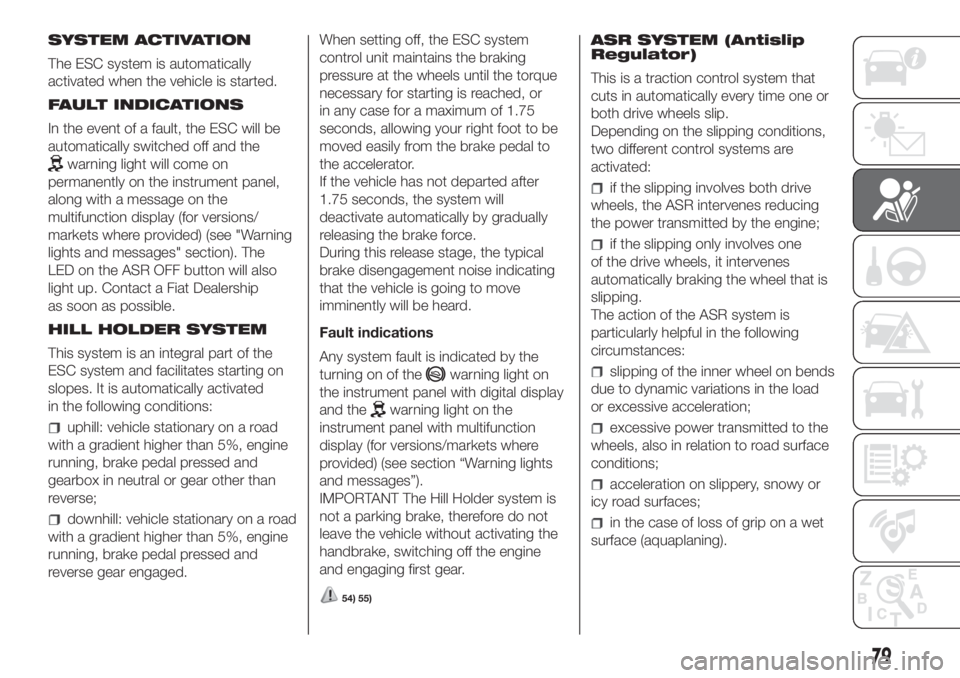
SYSTEM ACTIVATION
The ESC system is automatically
activated when the vehicle is started.
FAULT INDICATIONS
In the event of a fault, the ESC will be
automatically switched off and the
warning light will come on
permanently on the instrument panel,
along with a message on the
multifunction display (for versions/
markets where provided) (see "Warning
lights and messages" section). The
LED on the ASR OFF button will also
light up. Contact a Fiat Dealership
as soon as possible.
HILL HOLDER SYSTEM
This system is an integral part of the
ESC system and facilitates starting on
slopes. It is automatically activated
in the following conditions:
uphill: vehicle stationary on a road
with a gradient higher than 5%, engine
running, brake pedal pressed and
gearbox in neutral or gear other than
reverse;
downhill: vehicle stationary on a road
with a gradient higher than 5%, engine
running, brake pedal pressed and
reverse gear engaged.When setting off, the ESC system
control unit maintains the braking
pressure at the wheels until the torque
necessary for starting is reached, or
in any case for a maximum of 1.75
seconds, allowing your right foot to be
moved easily from the brake pedal to
the accelerator.
If the vehicle has not departed after
1.75 seconds, the system will
deactivate automatically by gradually
releasing the brake force.
During this release stage, the typical
brake disengagement noise indicating
that the vehicle is going to move
imminently will be heard.
Fault indications
Any system fault is indicated by the
turning on of the
warning light on
the instrument panel with digital display
and the
warning light on the
instrument panel with multifunction
display (for versions/markets where
provided) (see section “Warning lights
and messages”).
IMPORTANT The Hill Holder system is
not a parking brake, therefore do not
leave the vehicle without activating the
handbrake, switching off the engine
and engaging first gear.
54) 55)
ASR SYSTEM (Antislip
Regulator)
This is a traction control system that
cuts in automatically every time one or
both drive wheels slip.
Depending on the slipping conditions,
two different control systems are
activated:
if the slipping involves both drive
wheels, the ASR intervenes reducing
the power transmitted by the engine;
if the slipping only involves one
of the drive wheels, it intervenes
automatically braking the wheel that is
slipping.
The action of the ASR system is
particularly helpful in the following
circumstances:
slipping of the inner wheel on bends
due to dynamic variations in the load
or excessive acceleration;
excessive power transmitted to the
wheels, also in relation to road surface
conditions;
acceleration on slippery, snowy or
icy road surfaces;
in the case of loss of grip on a wet
surface (aquaplaning).
79
Page 82 of 272
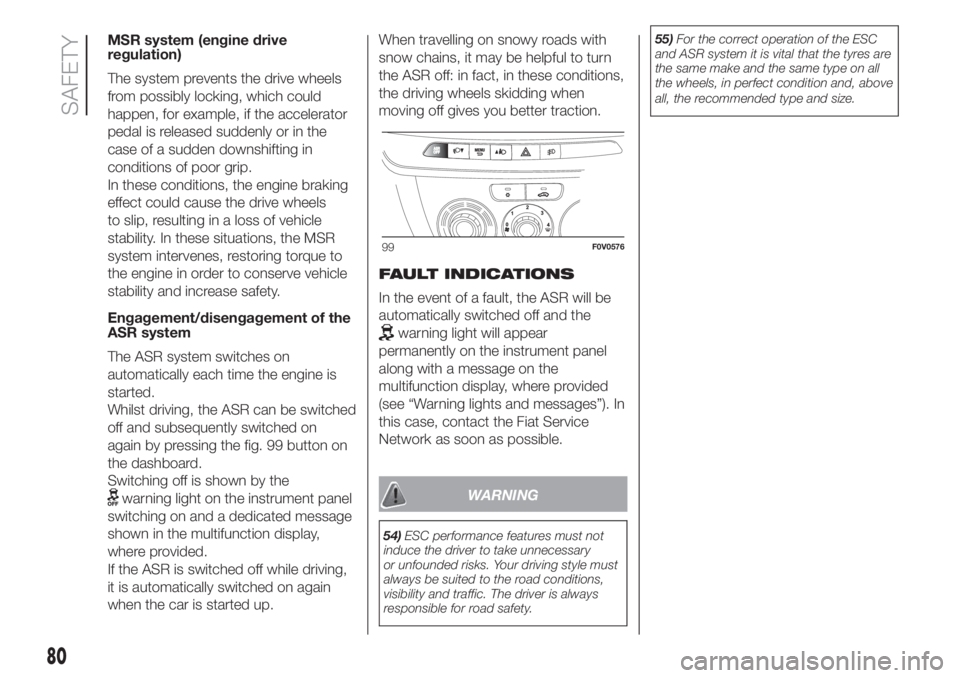
MSR system (engine drive
regulation)
The system prevents the drive wheels
from possibly locking, which could
happen, for example, if the accelerator
pedal is released suddenly or in the
case of a sudden downshifting in
conditions of poor grip.
In these conditions, the engine braking
effect could cause the drive wheels
to slip, resulting in a loss of vehicle
stability. In these situations, the MSR
system intervenes, restoring torque to
the engine in order to conserve vehicle
stability and increase safety.
Engagement/disengagement of the
ASR system
The ASR system switches on
automatically each time the engine is
started.
Whilst driving, the ASR can be switched
off and subsequently switched on
again by pressing the fig. 99 button on
the dashboard.
Switching off is shown by the
warning light on the instrument panel
switching on and a dedicated message
shown in the multifunction display,
where provided.
If the ASR is switched off while driving,
it is automatically switched on again
when the car is started up.When travelling on snowy roads with
snow chains, it may be helpful to turn
the ASR off: in fact, in these conditions,
the driving wheels skidding when
moving off gives you better traction.
FAULT INDICATIONS
In the event of a fault, the ASR will be
automatically switched off and the
warning light will appear
permanently on the instrument panel
along with a message on the
multifunction display, where provided
(see “Warning lights and messages”). In
this case, contact the Fiat Service
Network as soon as possible.
WARNING
54)ESC performance features must not
induce the driver to take unnecessary
or unfounded risks. Your driving style must
always be suited to the road conditions,
visibility and traffic. The driver is always
responsible for road safety.55)For the correct operation of the ESC
and ASR system it is vital that the tyres are
the same make and the same type on all
the wheels, in perfect condition and, above
all, the recommended type and size.
99F0V0576
80
SAFETY
Page 85 of 272
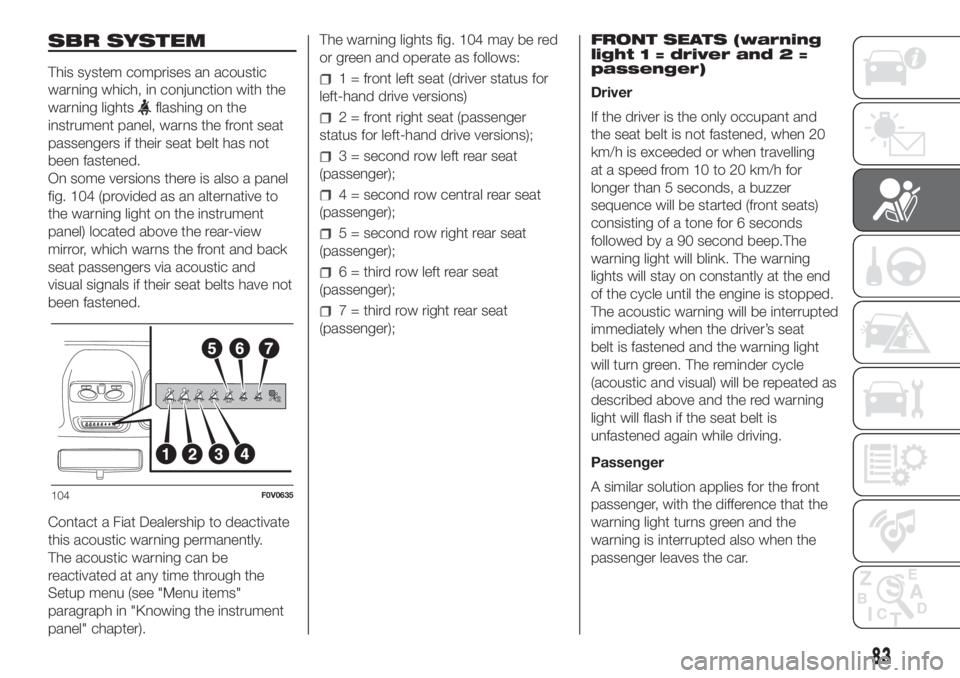
SBR SYSTEM
This system comprises an acoustic
warning which, in conjunction with the
warning lights
flashing on the
instrument panel, warns the front seat
passengers if their seat belt has not
been fastened.
On some versions there is also a panel
fig. 104 (provided as an alternative to
the warning light on the instrument
panel) located above the rear-view
mirror, which warns the front and back
seat passengers via acoustic and
visual signals if their seat belts have not
been fastened.
Contact a Fiat Dealership to deactivate
this acoustic warning permanently.
The acoustic warning can be
reactivated at any time through the
Setup menu (see "Menu items"
paragraph in "Knowing the instrument
panel" chapter).The warning lights fig. 104 may be red
or green and operate as follows:
1 = front left seat (driver status for
left-hand drive versions)
2 = front right seat (passenger
status for left-hand drive versions);
3 = second row left rear seat
(passenger);
4 = second row central rear seat
(passenger);
5 = second row right rear seat
(passenger);
6 = third row left rear seat
(passenger);
7 = third row right rear seat
(passenger);FRONT SEATS (warning
light 1 = driver and 2 =
passenger)
Driver
If the driver is the only occupant and
the seat belt is not fastened, when 20
km/h is exceeded or when travelling
at a speed from 10 to 20 km/h for
longer than 5 seconds, a buzzer
sequence will be started (front seats)
consisting of a tone for 6 seconds
followed by a 90 second beep.The
warning light will blink. The warning
lights will stay on constantly at the end
of the cycle until the engine is stopped.
The acoustic warning will be interrupted
immediately when the driver’s seat
belt is fastened and the warning light
will turn green. The reminder cycle
(acoustic and visual) will be repeated as
described above and the red warning
light will flash if the seat belt is
unfastened again while driving.
Passenger
A similar solution applies for the front
passenger, with the difference that the
warning light turns green and the
warning is interrupted also when the
passenger leaves the car.
104F0V0635
83
Page 104 of 272
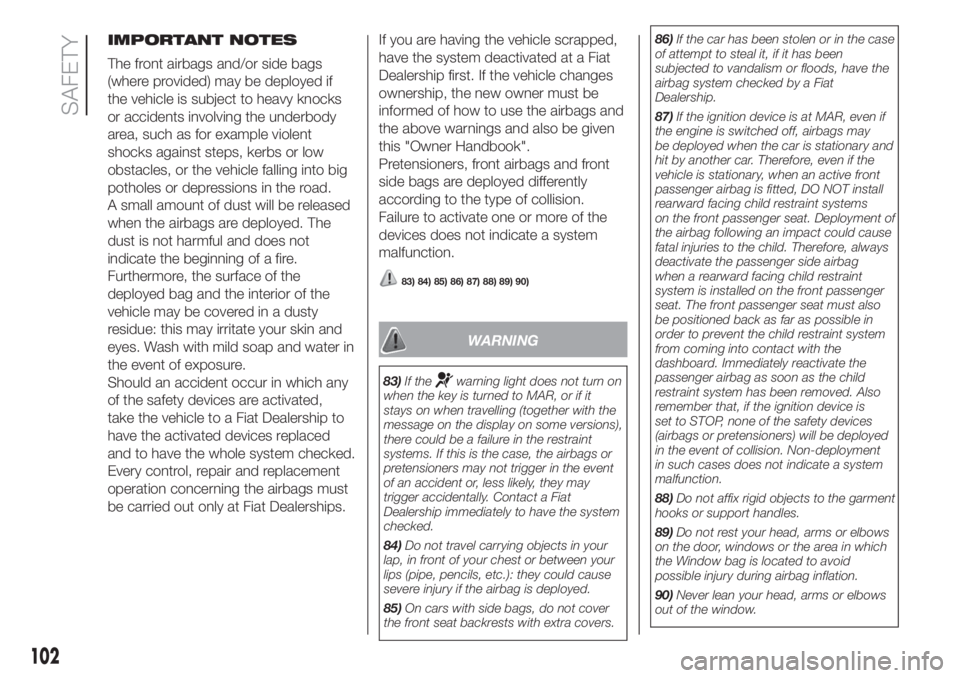
IMPORTANT NOTES
The front airbags and/or side bags
(where provided) may be deployed if
the vehicle is subject to heavy knocks
or accidents involving the underbody
area, such as for example violent
shocks against steps, kerbs or low
obstacles, or the vehicle falling into big
potholes or depressions in the road.
A small amount of dust will be released
when the airbags are deployed. The
dust is not harmful and does not
indicate the beginning of a fire.
Furthermore, the surface of the
deployed bag and the interior of the
vehicle may be covered in a dusty
residue: this may irritate your skin and
eyes. Wash with mild soap and water in
the event of exposure.
Should an accident occur in which any
of the safety devices are activated,
take the vehicle to a Fiat Dealership to
have the activated devices replaced
and to have the whole system checked.
Every control, repair and replacement
operation concerning the airbags must
be carried out only at Fiat Dealerships.If you are having the vehicle scrapped,
have the system deactivated at a Fiat
Dealership first. If the vehicle changes
ownership, the new owner must be
informed of how to use the airbags and
the above warnings and also be given
this "Owner Handbook".
Pretensioners, front airbags and front
side bags are deployed differently
according to the type of collision.
Failure to activate one or more of the
devices does not indicate a system
malfunction.
83) 84) 85) 86) 87) 88) 89) 90)
WARNING
83)If thewarning light does not turn on
when the key is turned to MAR, or if it
stays on when travelling (together with the
message on the display on some versions),
there could be a failure in the restraint
systems. If this is the case, the airbags or
pretensioners may not trigger in the event
of an accident or, less likely, they may
trigger accidentally. Contact a Fiat
Dealership immediately to have the system
checked.
84)Do not travel carrying objects in your
lap, in front of your chest or between your
lips (pipe, pencils, etc.): they could cause
severe injury if the airbag is deployed.
85)On cars with side bags, do not cover
the front seat backrests with extra covers.86)If the car has been stolen or in the case
of attempt to steal it, if it has been
subjected to vandalism or floods, have the
airbag system checked by a Fiat
Dealership.
87)If the ignition device is at MAR, even if
the engine is switched off, airbags may
be deployed when the car is stationary and
hit by another car. Therefore, even if the
vehicle is stationary, when an active front
passenger airbag is fitted, DO NOT install
rearward facing child restraint systems
on the front passenger seat. Deployment of
the airbag following an impact could cause
fatal injuries to the child. Therefore, always
deactivate the passenger side airbag
when a rearward facing child restraint
system is installed on the front passenger
seat. The front passenger seat must also
be positioned back as far as possible in
order to prevent the child restraint system
from coming into contact with the
dashboard. Immediately reactivate the
passenger airbag as soon as the child
restraint system has been removed. Also
remember that, if the ignition device is
set to STOP, none of the safety devices
(airbags or pretensioners) will be deployed
in the event of collision. Non-deployment
in such cases does not indicate a system
malfunction.
88)Do not affix rigid objects to the garment
hooks or support handles.
89)Do not rest your head, arms or elbows
on the door, windows or the area in which
the Window bag is located to avoid
possible injury during airbag inflation.
90)Never lean your head, arms or elbows
out of the window.
102
SAFETY
Page 105 of 272
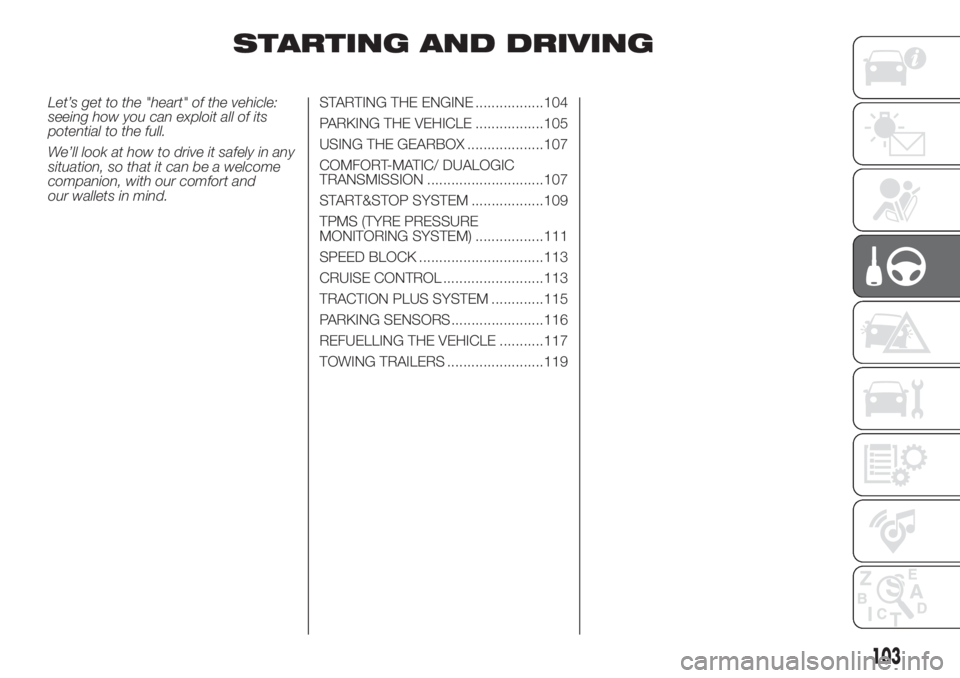
STARTING AND DRIVING
Let’s get to the "heart" of the vehicle:
seeing how you can exploit all of its
potential to the full.
We’ll look at how to drive it safely in any
situation, so that it can be a welcome
companion, with our comfort and
our wallets in mind.STARTING THE ENGINE .................104
PARKING THE VEHICLE .................105
USING THE GEARBOX ...................107
COMFORT-MATIC/ DUALOGIC
TRANSMISSION .............................107
START&STOP SYSTEM ..................109
TPMS (TYRE PRESSURE
MONITORING SYSTEM) .................111
SPEED BLOCK ...............................113
CRUISE CONTROL .........................113
TRACTION PLUS SYSTEM .............115
PARKING SENSORS.......................116
REFUELLING THE VEHICLE ...........117
TOWING TRAILERS ........................119
103
Page 106 of 272
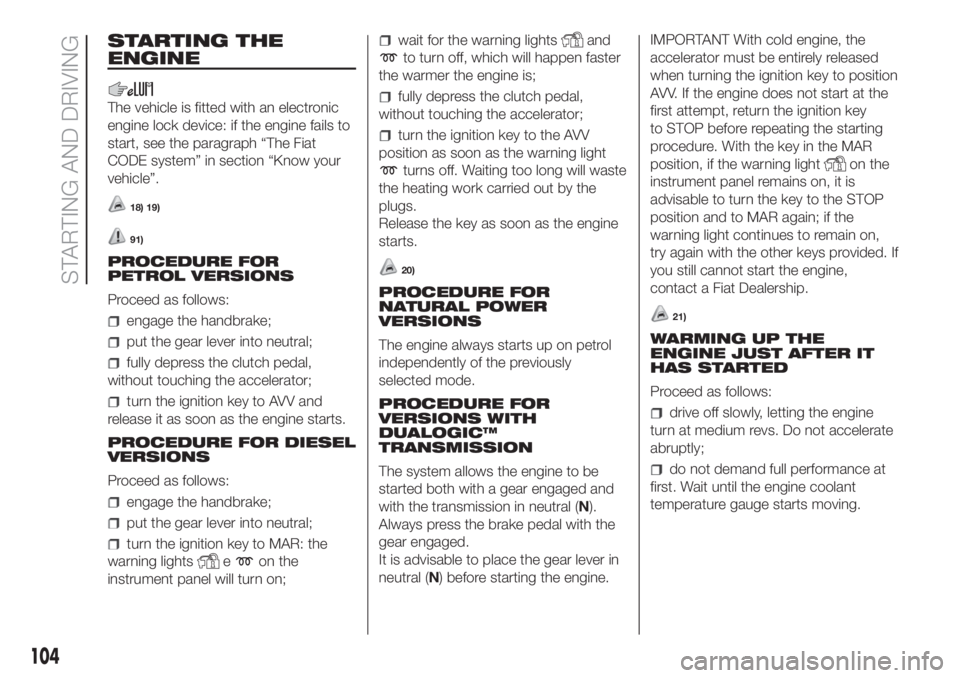
STARTING THE
ENGINE
The vehicle is fitted with an electronic
engine lock device: if the engine fails to
start, see the paragraph “The Fiat
CODE system” in section “Know your
vehicle”.
18) 19)
91)
PROCEDURE FOR
PETROL VERSIONS
Proceed as follows:
engage the handbrake;
put the gear lever into neutral;
fully depress the clutch pedal,
without touching the accelerator;
turn the ignition key to AVV and
release it as soon as the engine starts.
PROCEDURE FOR DIESEL
VERSIONS
Proceed as follows:
engage the handbrake;
put the gear lever into neutral;
turn the ignition key to MAR: the
warning lights
eon the
instrument panel will turn on;
wait for the warning lightsand
to turn off, which will happen faster
the warmer the engine is;
fully depress the clutch pedal,
without touching the accelerator;
turn the ignition key to the AVV
position as soon as the warning light
turns off. Waiting too long will waste
the heating work carried out by the
plugs.
Release the key as soon as the engine
starts.
20)
PROCEDURE FOR
NATURAL POWER
VERSIONS
The engine always starts up on petrol
independently of the previously
selected mode.
PROCEDURE FOR
VERSIONS WITH
DUALOGIC™
TRANSMISSION
The system allows the engine to be
started both with a gear engaged and
with the transmission in neutral (N).
Always press the brake pedal with the
gear engaged.
It is advisable to place the gear lever in
neutral (N) before starting the engine.IMPORTANT With cold engine, the
accelerator must be entirely released
when turning the ignition key to position
AVV. If the engine does not start at the
first attempt, return the ignition key
to STOP before repeating the starting
procedure. With the key in the MAR
position, if the warning light
on the
instrument panel remains on, it is
advisable to turn the key to the STOP
position and to MAR again; if the
warning light continues to remain on,
try again with the other keys provided. If
you still cannot start the engine,
contact a Fiat Dealership.
21)
WARMING UP THE
ENGINE JUST AFTER IT
HAS STARTED
Proceed as follows:
drive off slowly, letting the engine
turn at medium revs. Do not accelerate
abruptly;
do not demand full performance at
first. Wait until the engine coolant
temperature gauge starts moving.
104
STARTING AND DRIVING
Page 107 of 272
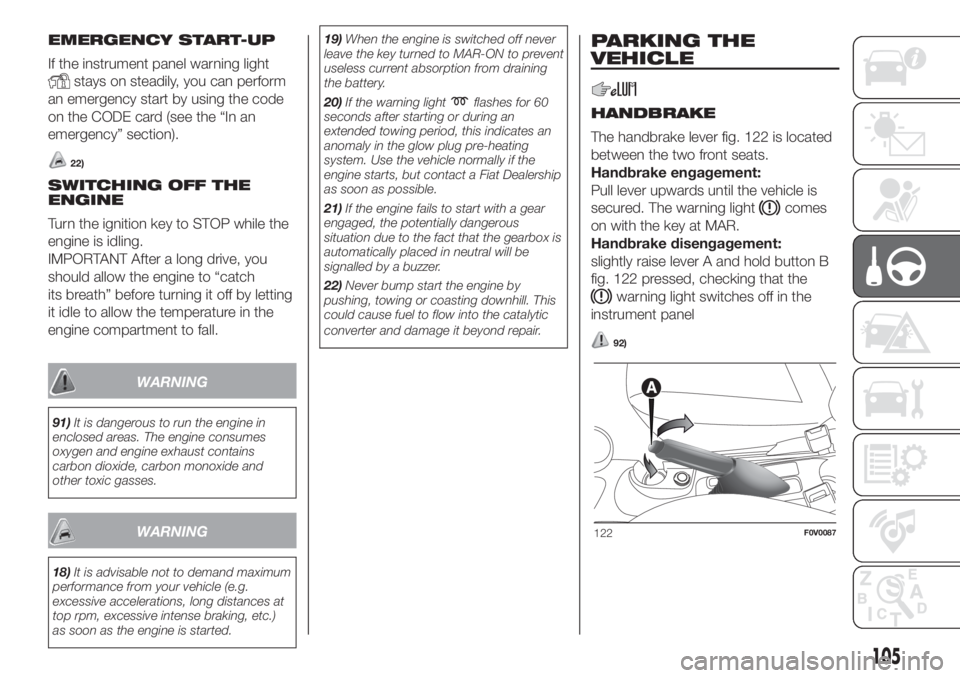
EMERGENCY START-UP
If the instrument panel warning light
stays on steadily, you can perform
an emergency start by using the code
on the CODE card (see the “In an
emergency” section).
22)
SWITCHING OFF THE
ENGINE
Turn the ignition key to STOP while the
engine is idling.
IMPORTANT After a long drive, you
should allow the engine to “catch
its breath” before turning it off by letting
it idle to allow the temperature in the
engine compartment to fall.
WARNING
91)It is dangerous to run the engine in
enclosed areas. The engine consumes
oxygen and engine exhaust contains
carbon dioxide, carbon monoxide and
other toxic gasses.
WARNING
18)It is advisable not to demand maximum
performance from your vehicle (e.g.
excessive accelerations, long distances at
top rpm, excessive intense braking, etc.)
as soon as the engine is started.19)When the engine is switched off never
leave the key turned to MAR-ON to prevent
useless current absorption from draining
the battery.
20)If the warning light
flashes for 60
seconds after starting or during an
extended towing period, this indicates an
anomaly in the glow plug preheating
system. Use the vehicle normally if the
engine starts, but contact a Fiat Dealership
as soon as possible.
21)If the engine fails to start with a gear
engaged, the potentially dangerous
situation due to the fact that the gearbox is
automatically placed in neutral will be
signalled by a buzzer.
22)Never bump start the engine by
pushing, towing or coasting downhill. This
could cause fuel to flow into the catalytic
converter and damage it beyond repair.
PARKING THE
VEHICLE
HANDBRAKE
The handbrake lever fig. 122 is located
between the two front seats.
Handbrake engagement:
Pull lever upwards until the vehicle is
secured. The warning light
comes
on with the key at MAR.
Handbrake disengagement:
slightly raise lever A and hold button B
fig. 122 pressed, checking that the
warning light switches off in the
instrument panel
92)
122F0V0087
105
Page 108 of 272
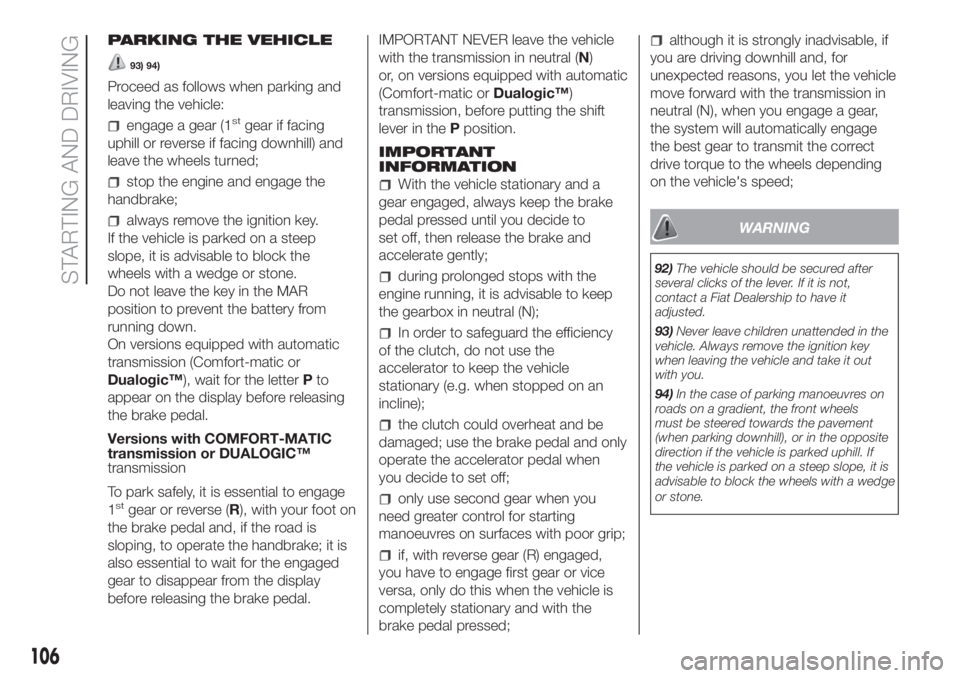
PARKING THE VEHICLE
93) 94)
Proceed as follows when parking and
leaving the vehicle:
engage a gear (1stgear if facing
uphill or reverse if facing downhill) and
leave the wheels turned;
stop the engine and engage the
handbrake;
always remove the ignition key.
If the vehicle is parked on a steep
slope, it is advisable to block the
wheels with a wedge or stone.
Do not leave the key in the MAR
position to prevent the battery from
running down.
On versions equipped with automatic
transmission (Comfort-matic or
Dualogic™), wait for the letterPto
appear on the display before releasing
the brake pedal.
Versions with COMFORT-MATIC
transmission or DUALOGIC™
transmission
To park safely, it is essential to engage
1
stgear or reverse (R), with your foot on
the brake pedal and, if the road is
sloping, to operate the handbrake; it is
also essential to wait for the engaged
gear to disappear from the display
before releasing the brake pedal.IMPORTANT NEVER leave the vehicle
with the transmission in neutral (N)
or, on versions equipped with automatic
(Comfort-matic orDualogic™)
transmission, before putting the shift
lever in thePposition.
IMPORTANT
INFORMATION
With the vehicle stationary and a
gear engaged, always keep the brake
pedal pressed until you decide to
set off, then release the brake and
accelerate gently;
during prolonged stops with the
engine running, it is advisable to keep
the gearbox in neutral (N);
In order to safeguard the efficiency
of the clutch, do not use the
accelerator to keep the vehicle
stationary (e.g. when stopped on an
incline);
the clutch could overheat and be
damaged; use the brake pedal and only
operate the accelerator pedal when
you decide to set off;
only use second gear when you
need greater control for starting
manoeuvres on surfaces with poor grip;
if, with reverse gear (R) engaged,
you have to engage first gear or vice
versa, only do this when the vehicle is
completely stationary and with the
brake pedal pressed;
although it is strongly inadvisable, if
you are driving downhill and, for
unexpected reasons, you let the vehicle
move forward with the transmission in
neutral (N), when you engage a gear,
the system will automatically engage
the best gear to transmit the correct
drive torque to the wheels depending
on the vehicle's speed;
WARNING
92)The vehicle should be secured after
several clicks of the lever. If it is not,
contact a Fiat Dealership to have it
adjusted.
93)Never leave children unattended in the
vehicle. Always remove the ignition key
when leaving the vehicle and take it out
with you.
94)In the case of parking manoeuvres on
roads on a gradient, the front wheels
must be steered towards the pavement
(when parking downhill), or in the opposite
direction if the vehicle is parked uphill. If
the vehicle is parked on a steep slope, it is
advisable to block the wheels with a wedge
or stone.
106
STARTING AND DRIVING
Page 109 of 272
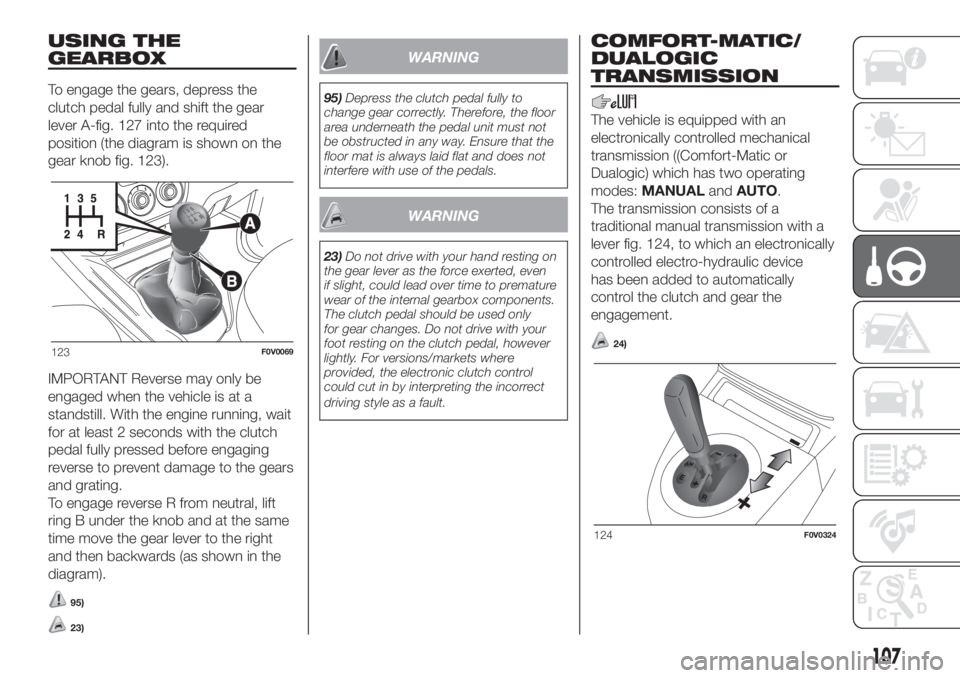
USING THE
GEARBOX
To engage the gears, depress the
clutch pedal fully and shift the gear
lever A-fig. 127 into the required
position (the diagram is shown on the
gear knob fig. 123).
IMPORTANT Reverse may only be
engaged when the vehicle is at a
standstill. With the engine running, wait
for at least 2 seconds with the clutch
pedal fully pressed before engaging
reverse to prevent damage to the gears
and grating.
To engage reverse R from neutral, lift
ring B under the knob and at the same
time move the gear lever to the right
and then backwards (as shown in the
diagram).
95)
23)
WARNING
95)Depress the clutch pedal fully to
change gear correctly. Therefore, the floor
area underneath the pedal unit must not
be obstructed in any way. Ensure that the
floor mat is always laid flat and does not
interfere with use of the pedals.
WARNING
23)Do not drive with your hand resting on
the gear lever as the force exerted, even
if slight, could lead over time to premature
wear of the internal gearbox components.
The clutch pedal should be used only
for gear changes. Do not drive with your
foot resting on the clutch pedal, however
lightly. For versions/markets where
provided, the electronic clutch control
could cut in by interpreting the incorrect
driving style as a fault.
COMFORT-MATIC/
DUALOGIC
TRANSMISSION
The vehicle is equipped with an
electronically controlled mechanical
transmission ((Comfort-Matic or
Dualogic) which has two operating
modes:MANUALandAUTO.
The transmission consists of a
traditional manual transmission with a
lever fig. 124, to which an electronically
controlled electro-hydraulic device
has been added to automatically
control the clutch and gear the
engagement.
24)123F0V0069
124F0V0324
107